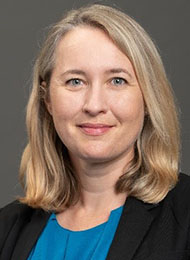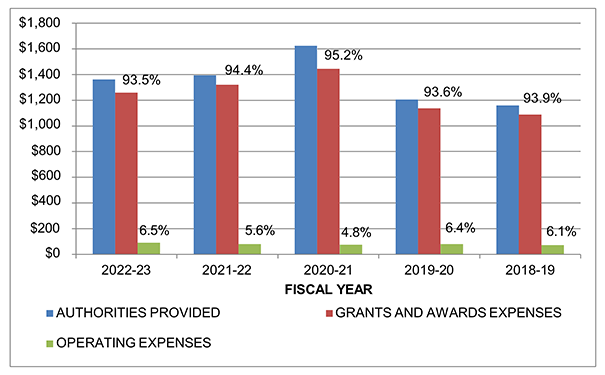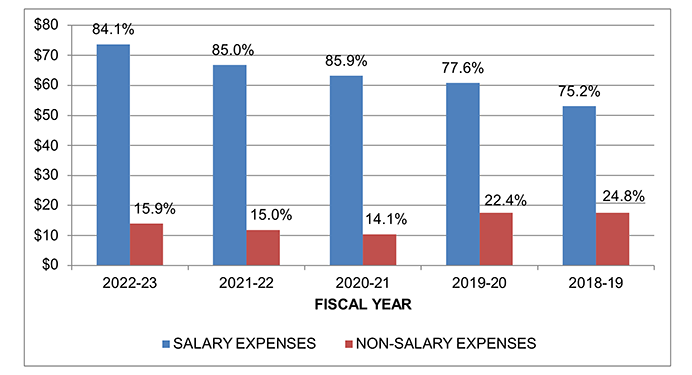Canadian Institutes of Health Research Annual Report 2022–23
Content
- Chair’s Message
- Providing Stewardship and Accountability
- Financial Statement Discussion and Analysis
- Financial Statements
- Independent auditor’s report
Message from the Chair of CIHR Governing Council

Dr. Marie-Josée Hébert
Chair, CIHR Governing Council
On behalf of the CIHR Governing Council, it is with great pleasure that I share the accomplishments of the Canadian Institutes of Health Research (CIHR) for the 2022-23 Annual Report. Since my appointment as Chair in September 2022, I have been honoured to work alongside our dedicated researchers, clinicians, and stakeholders who continue to advance health research and innovation in Canada.
The past year has been a testament to the resilience and determination of the Canadian health research community. Despite ongoing challenges posed by the global pandemic, we have witnessed remarkable achievements, ground- breaking discoveries, and transformative collaborations that have the potential to shape the future of health and healthcare in our nation and beyond.
As we reflect on the accomplishments of the previous year towards CIHR Strategic Plan 2021-2031, we are reminded of the crucial role that CIHR plays in supporting and nurturing the research ecosystem in Canada. The agency’s commitment to fostering excellence in health research remains unwavering as it continues to promote a culture of innovation, collaboration, and equity.
Advance research excellence in all its diversity
A key accomplishment this year was co-developing a more inclusive concept of research excellence, to support a research ecosystem which values and incents the various paths of scientific excellence that collectively will make Canada better prepared to tackle pressing challenges. The agency is currently assessing how CIHR's policies, programs, and processes align against this concept, and is beginning exploration of changes required to achieve a more inclusive approach.
In alignment with the Government of Canada’s commitment to open science and as a requirement of the Tri-agency Research Data Management (RDM) Policy, post- secondary institutions and research hospitals are now expected to have published plans for how they will provide their researchers with an environment that enables and supports research data management. CIHR has also started to pilot requirements for RDM plans within select strategic funding opportunities. The successful implementation of these policy requirements is helping to ensure that agency-funded studies are replicable and that research results are as accessible as possible.
To further support the research community and support the ethical conduct and rigorous oversight of clinical trials, CIHR has implemented a Policy Guide - Requirements for Registration and Disclosure of Results from Clinical Trials. This policy requires researchers to register their clinical trials and provides guidance on how to disclose their trial results. This policy guide fulfills Canada’s commitment to the World Health Organization’s Joint Statement on Public Disclosure of Results of Clinical Trials and aims to increase the value and efficiency of Canadian research funds, reduce reporting biases and waste in research, and contribute to better decision making in health.
CIHR has also advanced research excellence by enhancing national and international collaboration. For instance, in collaboration with Tri-agency Institutional Programs Secretariat, (TIPS), CIHR contributed to 34 new Canada Research Excellence Chairs (CERC) and 11 awards totalling $1.4 billion for large-scale research initiatives in strategic areas via the Canada First Research Excellence Fund. Similarly, through the New Frontiers in Research Fund (NFRF), managed by the Canada Research Coordinating Committee (CRCC), CIHR and its federal partners contributed $60 million this year to support the International Initiative for Research on Climate Change Adaptation and Mitigation. The initiative will leverage international investments and expertise to tackle global challenges caused by climate change by funding international projects to further the design and implementation of adaptation and mitigation strategies for vulnerable groups—those currently most affected by climate change impacts. CIHR continued to forge valuable international partnerships such as its long-standing partnership with the European Commission’s EU Framework Program and contributed another $5 million to support five multinational research teams in critical areas such as neurodegenerative diseases, rare diseases, and antimicrobial resistance.
Finally, following the February 2023 statement from Ministers Champagne, Duclos and Mendicino on protecting Canada’s research from foreign interference, the agency has been working closely with federal partners, including Innovation Science and Economic Development (ISED), Public Safety, the Natural Sciences and Engineering Research Council (NSERC) and the Social Science and Humanities Research Council (SSHRC) to enhance research security measures to further safeguard Canadian research and protect intellectual property.
Strengthen Canadian health research capacity
CIHR continues to enhance its rapid response capacity through its Centre for Research on Pandemic Preparedness and Health Emergencies, which invested $21 million to support a diverse array of research projects related to pandemics and health emergencies. This includes research on post-COVID-19 condition, Ebola, behavioural sciences to address misinformation and improve vaccine confidence, building multidisciplinary teams that work across the human, animal, and environmental health pillars (i.e., building capacity in One Health), and health human resource planning in preparation for the next health emergency. By investing in these critical areas, we aim to ensure Canada's readiness to respond effectively to future health crises. The agency also announced $23 million from Budget 2021 to establish the Canadian Pediatric Cancer Consortium (CPCC) representing the largest investment in childhood cancer research in Canada to date.
In addition to these critical investments, CIHR has been working hard to effect meaningful systemic changes to build a more equitable, diverse and inclusive health research ecosystem. Recognizing the importance of representation and diversity in the funding process, the agency launched and expanded the Tri-agency Self-Identification Questionnaire. This allows applicants and reviewers to voluntarily provide information regarding their personal characteristics, thus allowing CIHR to gain a better understanding of representation and improve equity in the research funding process.
Further to this, CIHR continued its work to better understand and identify actions to address systemic racism and systemic ableism in the health research funding system. To inform CIHR’s Anti-Racism Action Plan, the agency concluded meetings with an external advisory committee and held small group dialogues with individuals impacted by racism. Similarly, to inform CIHR’s Accessibility and Systemic Ableism Action Plan, the agency continued to engage with an external advisory committee and held small group dialogues and launched a survey to better understand the challenges faced by individuals with disabilities within the research community. Summaries of what was heard related to anti-racism and anti-ableism are posted on CIHR’s website.
Lastly, CIHR piloted important innovations in training and career support as part of the agency’s efforts to support the researchers of tomorrow and foster their transition into independent careers. For instance, the Research Excellence, Diversity, and Independence Early Career Transition Awards and the Health System Impact Embedded Career Research Awards are providing aspiring researchers with the necessary resources and mentorship to launch their careers in their respective fields. CIHR also worked with fellow tri-agency partners, SSHRC and NSERC, to deliver Budget 2022 investments in Black scholars by increasing the number of awards.
Accelerate the Self-Determination of Indigenous Peoples in Health Research
The commitment to improving health outcomes and fostering meaningful partnerships with Indigenous communities has been front and center for CIHR this year, resulting in noteworthy progress that reflects an increased understanding of true reconciliation and cultural respect. For example, working in close partnership with Indigenous communities, the agency co-developed distinctions-based funding opportunities including one aiming to advance knowledge and capacity for First Nations in Biobanking and Genomics Research.
CIHR is also collaborating with the Inuit Tapiriit Kanatami leadership, renewing their commitment to improving health outcomes in Inuit communities by investing $6.4 million in an Inuit Research Network. Across the rest of the country, plans are also underway to renew the Network Environments for Indigenous Health Research investment, which includes an expansion to add a unit in the Yukon Territory.
To better understand and address issues relating to Indigenous Citizen and Membership, CIHR worked with its tri-agency partners to identify a culturally safe process to initiate on this important topic. As well, an Advisory Circle with First Nations, Inuit and Metis representation has been established to guide the process to select the next Scientific Director of the Institute for Indigenous People’s Health.
Removing administrative barriers has also been a key focus in our efforts to support Indigenous-led research. CIHR has made progress in the development of avenues to support shared research institution costs and is streamlining the application process for funding administration. These measures aim to facilitate and enhance the participation of Indigenous researchers and organizations in research activities, minimizing administrative burdens that could impede their contributions.
Finally, I am delighted to report that CIHR has met its commitment to advancing Indigenous health research by reaching its target investment in Indigenous-led research to 4.8% of the total grants and awards budget. Moving forward, and considering distinctions-based commitments, CIHR is exploring the possibility of Indigenous Health Research investment targets that reflect the current Indigenous population, aiming for a target of 5%.
Pursue health equity through research
CIHR embarked on several key partnerships in its effort to advance health equity through research. In collaboration with SSHRC and the International Development Research Centre (IDRC), it embarked on the Women RISE Initiative, a ground-breaking $24 million partnership to support research to improve the health and socioeconomic well-being of women, particularly those from marginalized communities, as part of supporting the global recovery from COVID-19. Additionally, to deliver on the Budget 2021 commitment to address the unique health needs of women and advance gender equity in healthcare, CIHR partnered with Women and Gender Equality Canada to launch the National Women's Health Research Initiative, which will invest $20 million over five years.
Under the leadership of its Centre for Research on Pandemic Preparedness and Health Emergencies, CIHR and IRDC worked together to invest $5.5 million to respond to Mpox in Canada and globally. This funding facilitated the collaboration of multi-country research teams in Canada, Nigeria, and the Democratic Republic of Congo. Furthermore, the agency invested $9.6 million in five Canadian teams as part of the Global Alliance for Chronic Diseases funding call to support research aimed at preventing and managing chronic diseases, addressing global health inequities, and promoting health equity across diverse populations.
Finally, in order to foster healthy and livable cities and address the unique health challenges faced by urban populations, CIHR partnered with the Public Health Agency of Canada (PHAC) to fund six implementation science research teams to address determinants of health to lead to effective prevention practices. These teams will investigate interventions to promote health in urban settings, with a total investment of $27 million over six years by supporting research that focuses on areas such as physical activity, diabetes and healthy aging.
Integrate evidence in health decisions
CIHR continues to prioritize investments in research at all stages of discovery and is focused on innovation and generating evidence to support health system transformation.This aims to deliver better outcomes, while improving the health care experience amongst patients, families, and health practitioners.
Several knowledge mobilization activities took place this year. For example, CIHR developed a new definition of knowledge mobilization and advanced work on its knowledge mobilization framework and action plan by engaging with diverse stakeholders through a nation-wide public consultation process. CIHR’s Café Scientifique program underwent a refresh and relaunch, to provide funding to organize events that enable knowledge sharing and dialogue between the general public and health research experts.
Key investments include $20 million from Budget 2022 was invested to support a pan- Canadian Post COVID-19 Condition Research Network called Long COVID Web to develop accurate diagnostics, treatments, and rehabilitation strategies for PCC. Other notable investments include an additional $20.2 million in COVID-19 research through seven research grants in areas such as therapeutics, child health, and research to accelerate public and clinical healthcare decision-making related to COVID-19.
CIHR continued to collaborate with federal colleagues to advance the evidence-based policy agenda of the Government of Canada. This includes CIHR’s delivery, as a component of the Government’s Biomanufacturing and Life Sciences Strategy, of
$163.1 million in funding for a clinical trials consortium, training platforms and clinical trials projects through the Clinical Trials Fund. CIHR also leveraged the $20 million committed through Budget 2022’s National Dementia Strategy into a $38.3 million investment over five years towards a new Brain Health and Cognitive Impairment in Aging Research Initiative to support research across the continuum from the healthy aging brain to cognitive impairment and care for those impacted by dementia, as well as the wellbeing of their caregivers. Finally, $32 million over five years from Budget 2021 was funded to advance rare disease research, and support initiatives that develop improved diagnostics and treatments for traditionally underserved populations.
Another key partnership between CIHR, the Graham Boeckh Foundation, the Bell-GBF Partnership and the RBC Foundation was forged this year to support the Integrated Youth Services Network of Networks (IYS-Net) initiative. Through this initiative, CIHR is working with provincial, territorial and Indigenous partners across the country to fund research to help create a Canada-wide network of provincial and territorial learning health systems for IYS that will ensure equitable access to mental health and substance use services for youth from coast to coast to coast. In phase one of this multi-phase initiative, over $15 million has been committed to establish an IYS research network in each of the 13 provinces and territories, as well as an Indigenous network.
Continued efforts through IYS-Net will allow for the creation of a pan-Canadian network that enables research evidence, data, and the lived experience to effectively inform and enhance services delivery for youth.
Finally, through Canada’s Strategy for Patient-Oriented Research (SPOR) CIHR renewed the Support for People and Patient-Oriented Research and Trials (SUPPORT) Unit investment, a combined investment of $323 million over six years among provincial and territorial government and non-government agencies, Indigenous governments and organizations, universities, hospital foundations and CIHR. These Units will continue to provide critical infrastructure across Canada to connect research with patient needs so that patient- and community- focused evidence-based solutions can be applied to health care.
Organizational Excellence
CIHR progressed in strengthening and modernizing its management maturity to maximize its support to the research community. For example, CIHR published its Accessibility Plan to comply with the Accessible Canada Act and made important updates to its internal Mental Health Strategy including an Action Plan aimed at reducing stigma and promote employee wellness in the workplace. Furthermore, CIHR enhanced its internal Conflict of Interest policy framework providing employees and other stakeholders with important resources to support conflict of interest processes and governance.
Below you will find the financial details of this report and can learn more about other key investments that CIHR has made to support new scientific knowledge and enable its translation into improved health and a strengthened Canadian health care system.
Sincerely,
Dr. Marie-Josée Hébert
Chair, CIHR Governing Council
Providing Stewardship and Accountability
CIHR Governing Council
CIHR reports to Parliament through the Minister of Health. Its Governing Council comprises a group of up to 16 members appointed by the Governor in Council, as well as the President of CIHR and the Deputy Minister of Health who are ex-officio non-voting members. Together they provide oversight and strategic direction for the organization and evaluate its overall performance.

Marie-Josée Hébert
Chair
Professor
Faculty of Medicine Université de Montréal

Deborah DeLancey
Former Deputy Minister
Health and Social Services NWT

Josette-Renée Landry
President and CEO,
Génome Québec
Adjunct Professor,
Faculty of Health Sciences, University of Ottawa
Adjunct Professor,
Faculty of Medicine, University of Montreal

Alice B. Aiken
Vice-Chair
(Until November 29, 2023)
Vice President (Research & Innovation)
Dalhousie University

Mark S. Dockstator
(Until November 29, 2023)
Associate Professor
Trent University
Chanie Wenjack School of Indigenous Studies

Stephen Lucas
(Ex-officio, non-voting member)
Deputy Minister of Health
Health Canada

Paul Allison
Faculty of Dental Medicine & Oral Health Sciences
McGill University

Nada Jabado
(Until November 29, 2023)
Senior Scientist, RI-MUHC, Glen site
Child Health and Human Development Program

Amélie Quesnel-Vallée
Professor, Departments of Sociology & Epidemiology
McGill University

Brenda Andrews
(Until November 29, 2023)
University Professor
Donnelly Centre for Cellular and Biomolecular Research
Department of Molecular Genetics
University of Toronto

Shanthi Johnson
Professor and Vice President – Research and Innovation
University of Windsor

Michael Salter
Senior Scientist, Neurosciences & Mental Health and Chief of Research Emeritus
The Hospital for Sick Children

Robert Bell
Former Ontario Deputy Minister of Health and Long-Term Care

Brianne Kent
Assistant Professor at Simon Fraser University

Michael Strong
(Ex-officio, non-voting member)
President, CIHR

Marcello Tonelli
(Until November 29, 2023)
Senior Associate Dean (Health Research), Cumming School of Medicine
Associate Vice President (Health Research), University of Calgary
Financial Statement Discussion and Analysis
Introduction
The following Financial Statement Discussion and Analysis (FSD&A) should be read in conjunction with the Canadian Institutes of Health Research (CIHR) audited financial statements and accompanying notes for the year ended March 31, 2023.
The responsibility for the integrity and objectivity of the FSD&A rests with the management of CIHR. The purpose of the FSD&A is to highlight information and provide explanations to enhance the user’s understanding of CIHR’s financial position and results of operations, while demonstrating CIHR’s accountability for its resources.
Additional information on CIHR’s performance is available in the CIHR Departmental Results Report, and information on its plans and priorities is available in the CIHR Department Plan.
Overview
The Canadian Institutes of Health Research was established in June 2000 under the Canadian Institutes of Health Research Act. It is listed in Schedule II to the Financial Administration Act as a departmental corporation. CIHR’s objective is to excel, according to international standards of scientific excellence, in the creation of new knowledge, and its translation into improved health, more effective health services and products, and a strengthened Canadian health care system.
CIHR’s budget is allocated through authorities approved by Parliament. CIHR has separate voted authorities for operating expenses and for grants/awards. Authorities provided to CIHR by Parliament do not parallel financial reporting according to Canadian public sector accounting standards, since authorities are primarily based on cash accounting principles. Consequently, items recognized in the Statement of Financial Position, the Statement of Operations and Departmental Net Financial Position, the Statement of Change in Departmental Net Debt, and the Statement of Cash Flows are not necessarily the same as those provided through authorities from Parliament. Note 3 of the Financial Statements provides users with a reconciliation between the two bases of reporting.
Highlights
CIHR’s financial results in 2022-23 are consistent with those of the preceding fiscal year.
1. Statement of Financial Position
| As at March 31 | 2023 | 2022 | % change |
|---|---|---|---|
| Total liabilities | $13.8 | $13.4 | 3.0% |
| Total financial and non-financial assets | $12.7 | $13.8 | (7.9)% |
The increase in total liabilities of $0.4 million is primarily due to an increase ($0.7 million) in the amount accrued for salaries and wages, an increase ($0.2 million) in payables due to other government departments and a small increase ($0.1 million) in the amount accrued for outstanding invoices to external vendors at fiscal year-end. These increases were offset by a decrease ($0.6 million) in the vacation and compensatory leave accrual as more vacation was used by employees in 2022-23 compared to 2021-22 due to easing of pandemic restrictions.
Total financial and non-financial assets decreased by $1.1 million due to a decrease ($1.6 million) in accounts receivable related to other government departments and agencies. There was also a decrease ($0.9 million) in the net book value of tangible capital assets due to amortization expenses exceeding $1.1 million in 2022-23. Due to CIHR’s planned move to a new office building in 2024 and the ongoing decommissioning of its current data centre, CIHR has limited its acquisition of capital assets. Furthermore, all existing systems are being moved to the cloud requiring no further capital investment. These decreases were offset by an increase ($1.0 million) in the amount due from the consolidated revenue fund, an increase ($0.3 million) in accounts receivables from external parties, and an increase ($0.1 million) in prepaid expenses.
2. Statement of Operations and Departmental Net Financial Position
| For the year ended March 31 | 2023 | 2022 | % change |
|---|---|---|---|
| Total expenses | $1,346.6 | $1,396.7 | (3.6)% |
| Net cost of operations before government funding and transfers | $1,339.4 | $1,390.6 | (3.7)% |
The decrease in both total expenses (3.6%) and in net cost of operations before government funding and transfers (3.7%) are mainly attributable to the total decrease ($30.6 million) in Parliamentary authorities provided to CIHR by the Government of Canada from the prior fiscal year. The decrease is primarily due to a decrease ($37.4 million) in grant authorities CIHR received and during the fiscal year due primarily to the sunsetting of COVID-19 targeted funding.
3. Variance Analysis
3.1 Variances between current year actual results and budget
CIHR’s 2022-23 year-end Parliamentary authorities of $1,362.3 million represents a decrease of $30.6 million (or 2.2%) compared to CIHR’s 2021-22 year-end authorities ($1,392.9 million).
This decrease is a key factor to note when comparing current year and prior year results for CIHR. The main reason for the current year decrease is due to a $37.4 million (2.8%) decrease in grant funding CIHR received during the year due mainly to the sunsetting of COVID-19 research funding initiatives.
| 2022-23 Main Estimates (in millions of dollars) | $1,242.5 |
|---|---|
| Funding for the Clinical Trials Fund | 85.8 |
| Funding for the Canada First Research Excellence Fund | 10.6 |
| Funding to respond to Monkeypox outbreaks in Canada | 10.3 |
| Net transfers from other government departments | 4.5 |
| 2021-22 Operating budget carry-forward | 3.1 |
| Funding for Long-term health impacts of COVID-19 | 1.4 |
| Funding for Dementia and Brain Health | 1.4 |
| Funding for scholarships and fellowships for Black student researchers | 1.3 |
| Funding for the National Women’s Health Research Initiative | 1.2 |
| Funding for building a World-Class Intellectual Property Regime | 0.2 |
| Total increase in Parliamentary authorities | 119.8 |
| 2022-23 Year-end Parliamentary authorities | $1,362.3 |
3.2 Variances between current year actual results and prior year actual results
| For the year ended March 31 | 2023 | 2022 | % change |
|---|---|---|---|
| Grants and awards | $1,259.1 | $1,318.2 | (4.5)% |
| Operating expenses | $87.5 | $78.5 | 11.5% |
Grants and awards expenses decreased by 4.5% (or $59.1 million) in 2022-23 due to decreased Parliamentary authorities provided to CIHR to support grant funding of $37.4 million, plus unused grant authorities totaling $19.3 million of grants for the Clinical Trials Fund program.
Total operating expenses increased by 11.5% ($9.0 million) over the previous year. This increase is mainly due to an increase of 10.3% ($6.9 million) in salaries and employment benefits because of an increase of 53 full-time equivalents (FTEs) compared to 2021-22. Furthermore, an increase of $1.2 million, (or 35.5%) for professional services expenditures related to several non-recurring contracts that were specific to fiscal year 2022-23 (for example, SAP-IRIS departmental financial management system onboarding costs) as well as increased conference and hospitality expenditures being incurred due to the lifting of COVID-19 restrictions. The remaining expense categories experienced immaterial fluctuations compared to the prior fiscal year.
4. Trend Analysis
4.1 Grants and Awards Expenses
(in millions of dollars)

Grants and Awards Expenses – Long Description
| 2022–23 | 2021–22 | 2020–21 | 2019–20 | 2018–19 | |
|---|---|---|---|---|---|
| Authorities provided | $1,362.3 | $1,392.9 | $1,624.2 | $1,205.7 | $1,158.9 |
| Grants and awards expenses | $1,259.1 | $1,318.2 | $1,443.8 | $1,136.5 | $1,088.9 |
| Operating expenses | $87.5 | $78.5 | $73.5 | $78.3 | $70.5 |
| Percentage grants and awards | 93.5% | 94.4% | 95.2% | 93.6% | 93.9% |
| Percentage operating expenses | 6.5% | 5.6% | 4.8% | 6.4% | 6.1% |
- The proportion of grants and awards expenses in relation to changes in the Parliamentary authorities fluctuate minimally from year to year.
- In 2022-23, grants and awards expenses made up 93.5% of total expenses, as compared to 94.4% in 2021-22.
4.2 Operating Expenses
(in millions of dollars)

Operating Expenses – Long Description
| 2022-23 | 2021-22 | 2020–21 | 2019–20 | 2018–19 | |
|---|---|---|---|---|---|
| Salary expenses | $73.6 | $66.7 | $63.1 | $60.7 | $53.0 |
| Non-salary expenses | $13.9 | $11.8 | $10.4 | $17.5 | $17.5 |
| Total | 87.5 | 78.5 | 73.5 | 78.2 | 70.5 |
| Percentage salary expenses | 84.1% | 85.0% | 85.9% | 77.6% | 75.2% |
| Percentage non-salary expenses | 15.9% | 15.0% | 14.1% | 22.4% | 24.8% |
- The ratio of operating expenses to total expenses was 6.5% in 2022-23 compared to 5.6% in 2021-22.
- Salary and employee benefit expenses increased by $6.9 million (or 10.3%) in 2022-23 compared to 2021-22 due to an increase in FTEs.
- In 2022-23, salaries and employee benefits made up 84.1% of total operating expenses compared to 85.0% in the prior year.
Financial Outlook
While Budget 2023 did not include any proposed investments directly in CIHR, new research funding will be provided to federal government partners for initiatives that align with CIHR’s research priorities that will ultimately help to create better health for Canadians. CIHR continues to be driven by Government of Canada priorities and is committed to maintaining its support to the research community. As such, CIHR will engage with these federal government partners to explore potential opportunities to collaborate with them to fund research or knowledge mobilization activities in support of its research priorities.
In its Budget 2023, the Government of Canada announced several initiatives to make life more affordable for Canadians, including the following:
- Reduced spending on consulting, other professional services and travel by roughly 15% for all federal agencies and departments.
- An across-the-board spending cut of 3% for all federal agencies and departments to be phased in by 2026-27.
CIHR’s budget is expected to be reduced by approximately $40M annually in future fiscal years resulting from the announcements included in Budget 2023. Additionally, CIHR’s total parliamentary authorities are expected to decrease slightly moving forward as a result of time-limited funding that was received through previous budgets for targeted research initiatives such as, COVID-19 related research and Monkeypox. CIHR’s annual planned spending is still estimated to be more than $1.25B in both 2024- 25 and 2025-26, which is higher than CIHR’s pre-pandemic parliamentary authority levels.
Financial Statements
Canadian Institutes of Health Research
Statement of Management Responsibility Including Internal Control over Financial Reporting
Responsibility for the integrity and objectivity of the accompanying financial statements for the year ended March 31, 2023, and all information contained in these financial statements rests with the management of the Canadian Institutes of Health Research (CIHR). These financial statements have been prepared by management using the Government of Canada’s accounting policies, which are based on Canadian public sector accounting standards.
Management is responsible for the integrity and objectivity of the information in these financial statements. Some of the information in the financial statements is based on management's best estimates and judgment, and gives due consideration to materiality. To fulfill its accounting and reporting responsibilities, management maintains a set of accounts that provides a centralized record of CIHR’s financial transactions. Financial information submitted in the preparation of the Public Accounts of Canada, and included in CIHR’s Departmental Results Report , is consistent with these financial statements.
Management is also responsible for maintaining an effective system of internal control over financial reporting (ICFR) designed to provide reasonable assurance that financial information is reliable, that assets are safeguarded and that transactions are properly authorized and recorded in accordance with the Financial Administration Act and other applicable legislation, regulations, authorities and policies.
Management seeks to ensure the objectivity and integrity of data in its financial statements through careful selection, training and development of qualified staff; through organizational arrangements that provide appropriate divisions of responsibility; through communication programs aimed at ensuring that regulations, policies, standards and managerial authorities are understood throughout CIHR; and through conducting an annual risk-based assessment of the effectiveness of the system of ICFR.
The system of ICFR is designed to mitigate risks to a reasonable level based on an ongoing process to identify key risks, to assess effectiveness of associated key controls, and to make any necessary adjustments.
A risk-based assessment of the system of ICFR for the year ended March 31, 2023 was completed in accordance with the Treasury Board
Policy on Financial Management and the results and action plans are summarized in the annex.Footnote 1
The effectiveness and adequacy of CIHR’s system of internal control are reviewed by of internal audit staff, who conduct periodic audits of different areas of CIHR’s operations, and by CIHR’s Audit Committee, which oversees management’s responsibilities for maintaining adequate control systems and the quality of financial reporting, and which recommends the financial statements to the President of CIHR and its Governing Council.
Ernst & Young LLP, the independent auditor for CIHR, has expressed an opinion on the fair presentation of the financial statements of CIHR, which does not include an audit opinion on the annual assessment of the effectiveness of CIHR’s internal controls over financial reporting.
Approved by:
Michael J. Strong, MD, FRCPC, FAAN, FCAHS
President
Jimmy Fecteau, MBA, CPA, CMA
Chief Financial Officer
Ottawa, Canada
July 5, 2023
Independent auditor’s report
To the Members of the Governing Council of the
Canadian Institutes of Health Research
Opinion
We have audited the financial statements of the Canadian Institutes of Health Research [the “Organization”], which comprise the statement of financial position as at March 31, 2023, and the statement of operations and departmental net financial position, statement of change in departmental net debt, and statement of cash flows for the year then ended, and notes to the financial statements, including a summary of significant accounting policies.
In our opinion, the accompanying financial statements present fairly, in all material respects, the financial position of the Organization as at March 31, 2023, and its results of operations and its cash flows for the year then ended in accordance with Canadian public sector accounting standards.
Basis for opinion
We conducted our audit in accordance with Canadian generally accepted auditing standards. Our responsibilities under those standards are further described in the Auditor’s responsibilities for the audit of the financial statements section of our report. We are independent of the Organization in accordance with the ethical requirements that are relevant to our audit of the financial statements in Canada, and we have fulfilled our other ethical responsibilities in accordance with these requirements. We believe that the audit evidence we have obtained is sufficient and appropriate to provide a basis for our opinion.
Responsibilities of management and those charged with governance for the financial statements
Management is responsible for the preparation and fair presentation of the financial statements in accordance with Canadian public sector accounting standards, and for such internal control as management determines is necessary to enable the preparation of financial statements that are free from material misstatement, whether due to fraud or error.
In preparing the financial statements, management is responsible for assessing the Organization’s ability to continue as a going concern, disclosing, as applicable, matters related to going concern and using the going concern basis of accounting unless management either intends to liquidate the Organization or to cease operations, or has no realistic alternative but to do so.
Those charged with governance are responsible for overseeing the Organization’s financial reporting process.
Auditor’s responsibilities for the audit of the financial statements
Our objectives are to obtain reasonable assurance about whether the financial statements as a whole are free from material misstatement, whether due to fraud or error, and to issue an auditor’s report that includes our opinion. Reasonable assurance is a high level of assurance, but is not a guarantee that an audit conducted in accordance with Canadian generally accepted auditing standards will always detect a material misstatement when it exists. Misstatements can arise from fraud or error and are considered material if, individually or in the aggregate, they could reasonably be expected to influence the economic decisions of users taken on the basis of these financial statements.
As part of an audit in accordance with Canadian generally accepted auditing standards, we exercise professional judgment and maintain professional skepticism throughout the audit. We also:
- Identify and assess the risks of material misstatement of the financial statements, whether due to fraud or error, design and perform audit procedures responsive to those risks, and obtain audit evidence that is sufficient and appropriate to provide a basis for our opinion. The risk of not detecting a material misstatement resulting from fraud is higher than for one resulting from error, as fraud may involve collusion, forgery, intentional omissions, misrepresentations, or the override of internal control.
- Obtain an understanding of internal control relevant to the audit in order to design audit procedures that are appropriate in the circumstances, but not for the purpose of expressing an opinion on the effectiveness of the Organization’s internal control.
- Evaluate the appropriateness of accounting policies used and the reasonableness of accounting estimates and related disclosures made by management.
- Conclude on the appropriateness of management’s use of the going concern basis of accounting and, based on the audit evidence obtained, whether a material uncertainty exists related to events or conditions that may cast significant doubt on the Organization’s ability to continue as a going concern. If we conclude that a material uncertainty exists, we are required to draw attention in our auditor’s report to the related disclosures in the financial statements or, if such disclosures are inadequate, to modify our opinion. Our conclusions are based on the audit evidence obtained up to the date of our auditor’s report. However, future events or conditions may cause the Organization to cease to continue as a going concern.
- Evaluate the overall presentation, structure, and content of the financial statements, including the disclosures, and whether the financial statements represent the underlying transactions and events in a manner that achieves fair presentation.
We communicate with those charged with governance regarding, among other matters, the planned scope and timing of the audit and significant audit findings, including any significant deficiencies in internal control that we identify during our audit.
Ernst & Young LLP
Chartered Professional Accountants
Licensed Public Accountants
Ottawa, Canada
July 5, 2023
Canadian Institutes of Health Research
Statement of Financial Position
As at March 31
(in thousands of dollars)
| 2023 | 2022 | |
|---|---|---|
| Liabilities | ||
| Accounts payable and accrued liabilities (note 4) | $6,988 | $5,966 |
| Vacation pay and compensatory leave | 4,422 | 5,059 |
| Deferred revenue (note 5) | 1,775 | 1,756 |
| Employee future benefits (note 6) | 653 | 635 |
| Total liabilities | 13,838 | 13,416 |
| Financial assets | ||
| Due from Consolidated Revenue Fund | 8,763 | 7,721 |
| Accounts receivable (note 7) | 659 | 2,047 |
| Total financial assets | 9,422 | 9,768 |
| Departmental net debt | 4,416 | 3,648 |
| Non-financial assets | ||
| Prepaid expenses | 690 | 564 |
| Tangible capital assets (note 8) | 2,569 | 3,443 |
| Total non-financial assets | 3,259 | 4,007 |
| Departmental net financial position | $(1,157) | $359 |
|
Contractual obligations (note 9) |
||
Approved by:
Michael J. Strong, MD, FRCPC, FAAN, FCAHS
President
Marie-Josée Hébert, MD, FRCPC, MACSS
Chair, Governing Council
Ottawa, Canada
July 5, 2023
Canadian Institutes of Health Research
Statement of Operations and Departmental Net Financial Position
For the year ended March 31
(in thousands of dollars)
| 2023 | 2023 | 2022 | |
|---|---|---|---|
| Planned Results (note 2) |
|||
| Expenses | |||
| Funding health research and training | $1,325,178 | $1,301,819 | $1,356,155 |
| Internal Services | 48,575 | 44,774 | 40,586 |
| Total expenses | 1,373,753 | 1,346,593 | 1,396,741 |
| Revenues | |||
| Funding health research and training | 7,483 | 7,157 | 6,188 |
| Total revenues | 7,483 | 7,157 | 6,188 |
| Net cost of operations before government funding and transfers | $1,366,270 | $1,339,436 | $1,390,553 |
| Government funding and transfers | |||
| Net cash provided by Government of Canada | $1,327,617 | $1,380,989 | |
| Change in due from the Consolidated Revenue Fund | 1,042 | (209) | |
| Services provided without charge by other government departments (note 11) | 9,261 | 8,935 | |
| Net cost of operations after government funding and transfers | 1,516 | 838 | |
| Departmental net financial position – beginning of year | 359 | 1,197 | |
| Departmental net financial position – end of year | $(1,157) | $359 | |
|
Segmented information (note 12) The accompanying notes form an integral part of these financial statements. |
|||
Canadian Institutes of Health Research
Statement of Change in Departmental Net Debt
For the year ended March 31
(in thousands of dollars)
| 2023 | 2022 | |
|---|---|---|
| Net cost of operations after government funding and transfers | $1,516 | $838 |
| Change due to tangible capital assets | ||
| Acquisition of tangible capital assets | 265 | 24 |
| Amortization of tangible capital assets | (1,138) | (1,288) |
| Loss on disposal of capital assets | (1) | - |
| Total change due to tangible capital assets | (874) | (1,264) |
| Change due to prepaid expenses | 126 | (41) |
| Net increase / (decrease) in departmental net debt | 768 | (467) |
| Departmental net debt – beginning of year | 3,648 | 4,115 |
| Departmental net debt – end of year | $4,416 | $3,648 |
|
The accompanying notes form an integral part of these financial statements. |
||
Canadian Institutes of Health Research
Statement of Cash Flows
For the Year ended March 31
(in thousands of dollars)
| 2023 | 2022 | |
|---|---|---|
| Operating activities | ||
| Net cost of operations before government funding and transfers | $1,339,436 | $1,390,553 |
| Non-cash items: | ||
| Amortization of tangible capital assets | (1,138) | (1,288) |
| Services provided without charge by other government departments (note 11) | (9,261) | (8,935) |
| (Loss) on disposal of tangible capital assets | (1) | - |
| Variations in Statement of Financial Position: | ||
| Decrease in accounts receivable | (1,388) | (9) |
| Increase/(Decrease) in prepaid expenses | 126 | (41) |
| Decrease in accounts payable and accrued liabilities | (1,022) | 209 |
| Decrease/(Increase) in vacation pay and compensatory leave | 637 | 446 |
| Decrease/(Increase) in deferred revenue | (19) | (1) |
| Decrease in future employee benefits | (18) | 31 |
| Cash used in operating activities | 1,327,352 | 1,380,965 |
| Capital investing activities | ||
| Acquisitions of tangible capital assets | 265 | 24 |
| Cash used in capital investing activities | 265 | 24 |
| Net cash provided by Government of Canada | $1,327,617 | $1,380,989 |
|
The accompanying notes form an integral part of these financial statements. |
||
Canadian Institutes of Health Research
Notes to the Financial Statements
As at March 31
(in thousands of dollars)
1. Authority and objectives
The Canadian Institutes of Health Research (CIHR) was established in June 2000 under the Canadian Institutes of Health Research Act , replacing the former Medical Research Council of Canada. It is listed in Schedule II to the Financial Administration Act as a departmental corporation.
CIHR’s objective is to excel, according to international standards of scientific excellence, in the creation of new knowledge, and its translation into improved health, more effective health services and products, and a strengthened Canadian health care system. CIHR’s core responsibility is funding health research and training . CIHR is Canada’s health research investment agency. By funding research excellence, CIHR supports the creation of new knowledge and its translation into improved health for Canadians, more effective health services and products and a strengthened Canadian health care system. This is done by providing grants that fund health research and/or provide career and training support to the current and next generation of researchers.
CIHR’s core responsibility is achieved based on three programs:
The first program is Investigator-Initiated Research, which provides funding to conduct research in any area related to health aimed at the discovery and application of knowledge. Funding is provided to researchers and academic organizations to conduct research, translate knowledge, and build capacity through research training and salaries. Applicants identify and propose the nature and scope of the research and compete for support by demonstrating excellence and the potential impact the research will have on health systems and/or health outcomes.
The second program is Training and Career Support, which provides award funding directly to promising current and next generation researchers to support training or career development. Applicants at different career stages compete through a rigorous process and those with the highest potential for promising research careers are funded.
The third program is Research in Priority Areas, which provides funding for targeted grants and awards aimed at addressing priority areas. Priorities are identified by CIHR in consultation with other government departments and agencies, partners and stakeholders. The program mobilizes researchers, patients, health providers, and decision makers to conduct research, enable knowledge translation and build capacity in the priority areas. It often requires collaboration within and across sectors.
CIHR is governed by a Governing Council of up to 18 members appointed by the Governor in Council. There are 16 members, including the Chair, that are voting members and two that are non-voting, ex officio members: the Deputy Minister of Health Canada and the President of CIHR. The Governing Council sets overall strategic direction, goals and policies and oversees programming, ethics, budget and planning.
CIHR has 13 institutes that focus on identifying the research needs and priorities for specific health areas, or for specific populations, then developing strategic initiatives to address those needs. Each institute is led by a Scientific Director who is guided by an Institute Advisory Board, which strives to include representation of the public, researcher communities, research funders, health professionals, health policy specialists and other users of research results.
CIHR’s grants, awards and operating expenditures are funded by budgetary authorities. Employee benefits are funded by statutory authorities.
2. Summary of significant accounting policies
These financial statements are prepared using CIHR’s accounting policies stated below, which are based on Canadian public sector accounting standards. The presentation and results using the stated accounting policies do not result in any significant differences from Canadian public sector accounting standards.
A statement of remeasurement gains and losses has not been included as it would not provide additional meaningful information for the users in the absence of items to report on such statement.
Significant accounting policies are as follows:
-
Parliamentary authorities
CIHR is financed by the Government of Canada through parliamentary authorities. Financial reporting of authorities provided to CIHR does not parallel financial reporting according to generally accepted accounting principles since authorities are primarily based on cash flow requirements. Consequently, items recognized in the Statement of Operations and Departmental Net Financial Position and in the Statement of Financial Position are not necessarily the same as those provided through authorities from Parliament. Note 3 provides a reconciliation between the bases of reporting. The planned results amounts in the “Expenses” and “Revenues” sections of the Statement of Operations and Departmental Net Financial Position are the amounts reported in the Future-oriented Statement of Operations (unaudited) included in the 2023-24 Departmental Plan . Planned results are not presented in the “Government funding and transfers” section of the Statement of Operations and Departmental Net Financial Position and in the Statement of Change in Departmental Net Debt because these amounts were not included in the 2023-24 Departmental Plan .
-
Net cash provided by Government of Canada
CIHR operates within the Consolidated Revenue Fund (CRF), which is administered by the Receiver General for Canada. All cash received by CIHR is deposited to the CRF and all cash disbursements made by CIHR are paid from the CRF. The net cash provided by Government of Canada is the difference between all cash receipts and all cash disbursements, including transactions between departments of the Government.
-
Amounts due from the CRF
Amounts due from CRF are the result of timing differences at year-end between when a transaction affects authorities and when it is processed through the CRF. Amounts due from the CRF represent the net amount of cash that CIHR is entitled to draw from the CRF without further authorities to discharge its liabilities.
-
Revenues
Funds received from external parties for specified purposes are recorded upon receipt as deferred revenue. Revenues are then recognized in the period in which the related expenses are incurred.
Deferred revenue consists of amounts received in advance of the delivery of goods and rendering of services that will be recognized as revenue in a subsequent fiscal year as it is earned.
Other revenues are recognized in the period the event giving rise to the revenues occurred.
-
Refunds of previous years' expenses
These amounts include the return of grants and awards funds to CIHR in the current fiscal year for expenses incurred in previous fiscal years due to cancellations, refunds of previous years' expenses related to goods or services, and adjustments of previous years' accounts payable. These refunds and adjustments are recorded as revenue in the year received.
-
Expenses
Grants and awards (transfer payments) are recorded as an expense in the year the transfer is authorized and all eligibility criteria have been met by the recipient. Vacation pay and compensatory leave are accrued as the benefits are earned by employees under their respective terms of employment.
Services provided without charge by other government departments for accommodation and employer contributions to the health and dental insurance plans are recorded as operating expenses at their carrying value.
-
Employee future benefits
- Pension benefits: Eligible employees participate in the Public Service Pension Plan (the Plan), a multiemployer defined benefit pension plan administered by the Government. CIHR’s contributions to the Plan are charged to expenses in the year incurred and represent the total departmental obligation to the Plan. CIHR’s responsibility with regard to the Plan is limited to its contributions. Actuarial surpluses or deficiencies are recognized in the financial statements of the Government of Canada, as the Plan’s sponsor.
- Severance benefits: The accumulation of severance benefits for voluntary departures ceased for CIHR executive and non-represented employees in 2011. The remaining obligation for employees who did not withdraw benefits is calculated on the retained accumulated weeks of severance at their current rate of pay as at March 31.
-
Accounts receivable
Accounts receivable are initially recorded at cost. When necessary, an allowance for valuation is recorded to reduce the carrying value of accounts receivable to amounts that approximate their net recoverable value.
-
Tangible capital assets
The costs of acquiring land, buildings, equipment and other capital property are capitalized as tangible capital assets and are amortized to expense over the estimated useful lives of the assets. All tangible capital assets having an individual initial cost of $10,000 or more are recorded at their acquisition cost.
Amortization of tangible capital assets is done on a straight-line basis over the estimated useful life of the capital asset as follows:
Asset class Amortization period Informatics hardware 3–5 years Informatics software 3–10 years Office equipment 10 years Vehicles 5 years Assets under construction are not amortized until they become available for use. The cost of a constructed asset includes direct construction or development costs (such as materials and/or labour) and overhead costs directly attributable to the construction or development activity.
-
Contingent liabilities
Contingent liabilities are potential liabilities that may become actual liabilities when one or more future events occur or fail to occur. If the future event is likely to occur or fail to occur, and a reasonable estimate of the loss can be made, a provision is accrued and an expense recorded to other expenses. If the likelihood is not determinable or an amount cannot be reasonably estimated, the contingency is disclosed in the notes to the financial statements.
-
Related party transactions
- Inter-entity transactions are transactions between commonly controlled entities. CIHR is a component of the Government of Canada reporting entity and is therefore related to all federal departments, agencies and Crown corporations. Inter-entity transactions are recorded on a gross basis and are measured at the carrying amount, except for the following:
- Services provided on a recovery basis are recognized as revenues and expenses on a gross basis and measured at the exchange amount.
- Certain services received on a without charge basis are recorded for departmental financial statements purposes at the carrying amount.
- Related parties include individuals who are members of key management personnel (KMP) or close family members of those individuals and entities controlled by, or under shared control of, a member of KMP or a close family member of that individual. KMP are individuals having the authority and responsibility for planning, directing and controlling the activities of CIHR. Related party transactions, other than inter-entity transactions, are recorded at the exchange value.
- Inter-entity transactions are transactions between commonly controlled entities. CIHR is a component of the Government of Canada reporting entity and is therefore related to all federal departments, agencies and Crown corporations. Inter-entity transactions are recorded on a gross basis and are measured at the carrying amount, except for the following:
-
Measurement uncertainty
The preparation of these financial statements requires management to make estimates and assumptions that affect the reported and disclosed amounts of assets, liabilities, revenues and expenses reported in the financial statements and accompanying notes at March 31. The estimates are based on facts and circumstances, historical experience and general economic conditions and reflect CIHR’s best estimate of the related amount at the end of the reporting period. The most significant items where estimates are used are contingent liabilities, the liability for employee future benefits and the useful life of tangible capital assets. Actual results could significantly differ from those estimated. Management’s estimates are reviewed periodically and, as adjustments become necessary, they are recorded in the financial statements in the year they become known.
-
New accounting standards
CIHR adopted the new accounting standards issued by the Public Sector Accounting Board that became effective on April 1, 2022 namely, PS 3450 Financial Instruments ("PS 3450"), PS 1201 Financial Statement Presentation ("PS 1201") and PS 2601 ("PS 2601") Foreign currency translation. PS 3450 addresses the recognition and derecognition, classification, measurement and disclosure of financial instruments. PS 1201 establishes general reporting principles for disclosure of information in the financial statements. PS 2601 establishes the accounting for and reporting of transactions that are denominated in a foreign currency. The adoption of these new standards did not result in any significant changes to CIHR's financial statements.
3. Parliamentary authorities
CIHR receives most of its funding through annual parliamentary authorities. Items recognized in the Statement of Operations and Departmental Net Financial Position and the Statement of Financial Position in one year may be funded through parliamentary authorities in prior, current or future years. Accordingly, CIHR has different net results of operations for the year on a government funding basis than on an accrual accounting basis. The differences are reconciled in the following tables:
-
Net cost of operations before government funding and transfers
2023 2022 Net cost of operations before government funding and transfers $1,339,436 $1,390,553 Adjustments for items affecting net cost of operations but not affecting authorities: Amortization of tangible capital assets (1,138) (1,288) Services provided without charge by other government departments (9,261) (8,935) Decrease/(Increase) in vacation pay and compensatory leave 637 446 Decrease in employee future benefits (18) 31 Refunds of previous years’ grants and awards 6,509 3,178 Bad debt expense (11) - Loss on disposal of tangible capital assets (1) - Other adjustments 109 283 (3,174) (6,285) Adjustments for items not affecting net cost of operations but affecting authorities: Acquisition of tangible capital assets 265 24 Increase in accounts receivable for salary overpayments 259 49 Increase/(Decrease) in prepaid expenses 126 (41) 650 32 Current year authorities used $1,336,912 $1,384,300 -
Authorities provided and used
2023 2022 Authorities provided: Vote 1 - Operating expenditures $74,442 $68,220 Vote 5 - Grants 1,279,597 1,317,018 Statutory amounts 8,298 7,625 Less: Frozen authorities (64) (1,040) Authorities available for future years (3,048) (3,144) Lapsed: Operating (1,199) (2,595) Lapsed: Grants (21,114) (1,784) Current year authorities used $1,336,912 $1,384,300
4. Accounts payable and accrued liabilities
The following table presents details of CIHR's accounts payable and accrued liabilities:
| 2023 | 2022 | |
|---|---|---|
| Accounts payable - other government departments and agencies | $746 | $560 |
| Accounts payable - external parties | - | 498 |
| Total accounts payable | 746 | 1,058 |
| Accrued liabilities | 6,242 | 4,908 |
| Total accounts payable and accrued liabilities | $6,988 | $5,966 |
5. Deferred revenue
Deferred revenue represents the balance at year-end of unearned revenues stemming from amounts received from external parties that are restricted in order to fund the expenditures related to specific research projects and stemming from amounts received for fees prior to services being performed. Revenue is recognized in the period in which these expenditures are incurred or in which the service is performed. Details of the transactions related to this account are as follows:
| 2023 | 2022 | |
|---|---|---|
| Opening balance | $1,756 | $1,755 |
| Amounts received | 667 | 3,011 |
| Revenue recognized | (648) | (3,010) |
| Closing balance | $1,775 | $1,756 |
6. Employee future benefits
-
Pension benefits
CIHR’s employees participate in the Plan, which is sponsored and administered by the Government of Canada. Pension benefits accrue up to a maximum period of 35 years at a rate of 2 percent per year of pensionable service, times the average of the best five consecutive years of earnings. The benefits are integrated with the Canada/Québec Pension Plans benefits and they are indexed to inflation.
Both the employees and CIHR contribute to the cost of the Plan. Due to the amendment of the Public Service Superannuation Act following the implementation of provisions related to Economic Action Plan 2012 , employee contributors have been divided into two groups – Group 1 relates to existing plan members as of December 31, 2012 and Group 2 relates to members joining the Plan as of January 1, 2013. Each group has a distinct contribution rate.
The 2022-23 employer contributions amount to $5,421 ($5,152 in 2021-22). For Group 1 members, the expense represents approximately 1.02 times (1.01 times in 2021- 22) the employee contributions and, for Group 2 members, approximately 1.00 times (1.00 times in 2021-22) the employee contributions.
CIHR’s responsibility with regard to the Plan is limited to its contributions. Actuarial surpluses or deficiencies are recognized in the Consolidated Financial Statements of the Government of Canada, as the Plan’s sponsor.
-
Severance benefits
Severance benefits provided to CIHR’s employees were previously based on an employee’s eligibility, years of service and salary at termination of employment. However, since 2011, the accumulation of severance benefits for voluntary departures progressively ceased for substantially all employees. Employees subject to these changes were given the option to be paid the full or partial value of benefits earned to date or collect the full or remaining value of benefits upon departure from the public service. By March 31, 2023, all settlements for immediate cash-out were completed. Severance benefits are unfunded and, consequently, the outstanding obligation will be paid from future authorities.
The changes in the obligations during the year were as follows:
2023 2022 Accrued benefit obligation - beginning of year $635 $666 Expense for the year 158 242 Benefits paid during the year (140) (273) Accrued benefit obligation - end of year $653 $635
7. Accounts receivable
The following table presents details of CIHR's accounts receivable balances:
| 2023 | 2022 | |
|---|---|---|
| Accounts receivable - other government departments and agencies | $18 | $1,672 |
| Accounts receivable - external parties | 652 | 375 |
| Allowance for doubtful accounts receivable from external parties | (11) | - |
| Total accounts receivable | $659 | $2,047 |
8. Tangible capital assets
| Cost | Accumulated amortization | Net book value | ||||||||
|---|---|---|---|---|---|---|---|---|---|---|
| Capital asset class | Opening balance | Acquisitions | Disposals and write-offs | Closing balance | Opening balance | Amortization | Disposals and write-offs | Closing balance | 2023 | 2022 |
| Informatics hardware | $1,727 | - | $ (29) | $1,698 | $1,282 | $166 | $ (29) | $1,419 | $279 | $445 |
| Informatics software | 20,978 | 134 | - | 21,112 | 19,201 | 967 | - | 20,168 | 944 | 1,777 |
| Office equipment | 23 | - | (12) | 11 | 11 | 1 | (11) | 1 | 10 | 12 |
| Vehicles | 30 | - | - | 30 | 15 | 4 | - | 19 | 11 | 15 |
| Assets under construction | 1,194 | 131 | - | 1,325 | - | - | - | - | 1,325 | 1,194 |
| Total | $23,952 | $265 | $ (41) | $24,176 | $20,509 | $1,138 | $ (40) | $21,607 | $2,569 | $3,443 |
9. Contractual obligations
The nature of CIHR’s programs may result in large multi-year contracts and obligations whereby CIHR will be obligated to make future payments in order to carry out its grants and awards payment programs or when the services/goods are received. Significant contractual obligations that can be reasonably estimated are summarized as follows:
| Grants and awards | Operating expenditures | Total | |
|---|---|---|---|
| 2024 | $1,067,195 | $1,354 | $1,068,549 |
| 2025 | 844,762 | 250 | 845,012 |
| 2026 | 556,559 | 160 | 556,719 |
| 2027 | 326,144 | 160 | 326,304 |
| 2028 | 168,056 | - | 168,056 |
| 2029 and subsequent | 134,257 | - | 134,257 |
| Total | $3,096,973 | $1,924 | $3,098,897 |
10. Contingent liabilities
CIHR may be subject to claims and litigation in the normal course of business. Management has not identified any claims with a material impact on the financial statements and, consequently, no provision has been made.
11. Related party transactions
-
Common services provided without charge by other government departments
During the year, CIHR received services without charge from certain common service organizations related to accommodation and the employer’s contribution to the health and dental insurance plans. These services provided without charge are recorded at the carrying value in CIHR’s Statement of Operations and Departmental Net Financial Position as follows:
2023 2022 Employer's contribution to the health and dental insurance plans $5,357 $5,040 Accomodation 3,904 3,895 Total $9,261 $8,935 The Government has centralized some of its administrative activities for efficiency, cost-effectiveness purposes and economic delivery of programs to the public. As a result, the Government uses central agencies and common service organizations so that one department performs services for all other departments and agencies without charge. The costs of these services, such as the payroll and cheque issuance services provided by Public Services and Procurement Canada, are not included in CIHR’s Statement of Operations and Departmental Net Financial Position.
-
Administration of programs on behalf of other government departments
Under a memorandum of understanding signed with the Natural Sciences and Engineering Research Council (NSERC) and the Social Sciences and Humanities Research Council (SSHRC), CIHR administers funds for the Vanier Canada Graduate Scholarship and Banting Postdoctoral Fellowship programs. During the year, CIHR incurred expenses of $23,429 ($23,750 in 2021-22) for grants and awards on behalf of NSERC and SSHRC. These expenses are reflected in the financial statements of NSERC and SSHRC and are not recorded in these financial statements.
12. Segmented information
Presentation by segment is based on CIHR’s core responsibilities. The presentation by segment is based on the same accounting policies as described in the Summary of Significant Accounting Policies in note 2. The following table presents the expenses incurred and revenues generated for the main core responsibilities, by major object of expense and by major type of revenue. The segment results for the year are as follows:
| 2023 | 2022 | |||
|---|---|---|---|---|
| Funding health research and training | Internal Services | Total | Total | |
| Grants and awards | $1,259,068 | - | $1,259,068 | $1,318,245 |
| Operating expenses | ||||
| Salaries and employee benefits | 39,344 | 34,255 | 73,599 | 66,699 |
| Travel | 132 | 165 | 297 | 3 |
| Professional and special services | 1,171 | 3,475 | 4,646 | 3,429 |
| Accomodation | 2,071 | 1,833 | 3,904 | 3,895 |
| Amortization of tangible capital assets | - | 1,138 | 1,138 | 1,288 |
| Rentals | 10 | 2,217 | 2,227 | 1,774 |
| Communication | 10 | 961 | 971 | 641 |
| Furniture, equipment and software | 7 | 520 | 527 | 579 |
| Utilities, materials and supplies | 1 | 36 | 37 | 12 |
| Other | 5 | 174 | 179 | 176 |
| Total operating expenses | 42,751 | 44,774 | 87,525 | 78,496 |
| Total expenses | $1,301,819 | $44,774 | $1,346,593 | $1,396,741 |
| Revenues | ||||
| Refunds of previous years' grants and awards | 6,509 | - | 6,509 | 3,178 |
| Donations for health research | 648 | - | 648 | 3,010 |
| Total revenues | 7,157 | - | 7,157 | 6,188 |
| Net cost from continuing operations | $1,294,662 | $44,774 | $1,339,436 | $1,390,553 |
- Date modified: